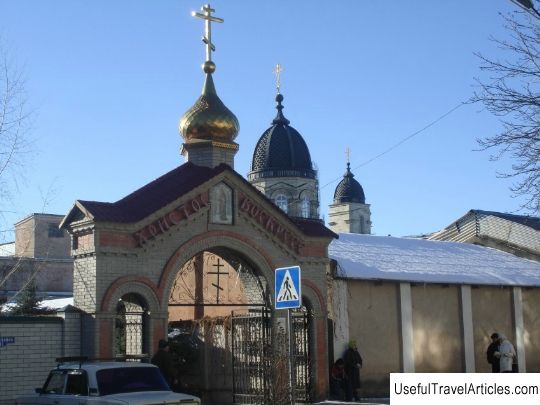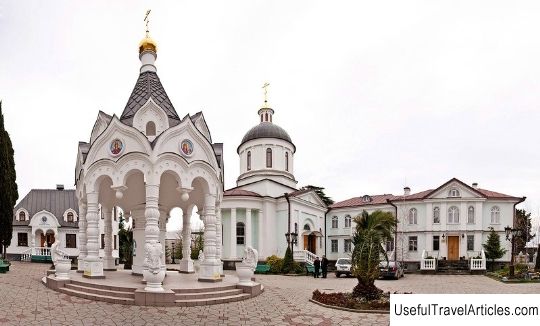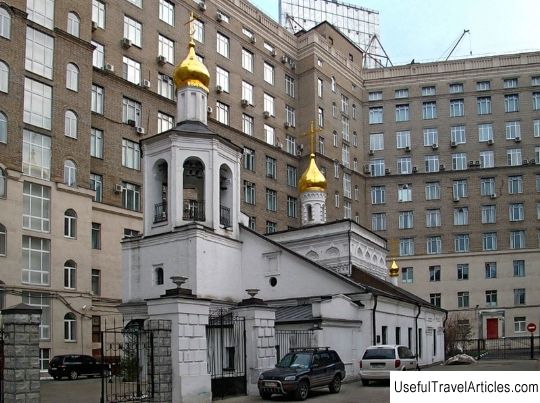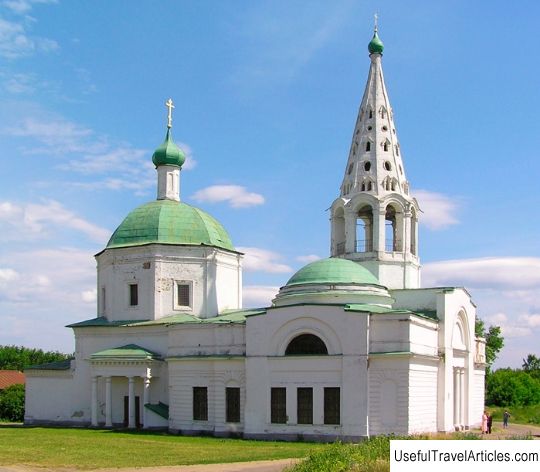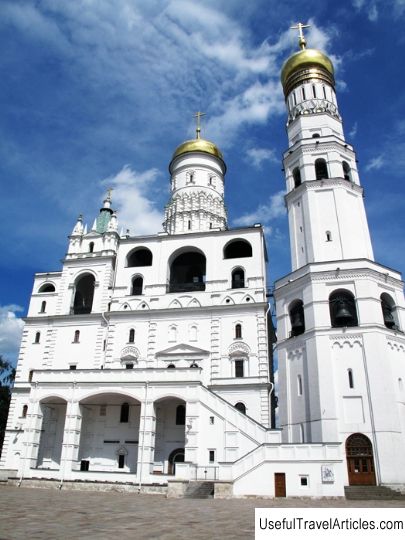Archangel Cathedral of the Kremlin description and photo - Russia - Moscow: Moscow
Rating: 8,1/10 (4023 votes) 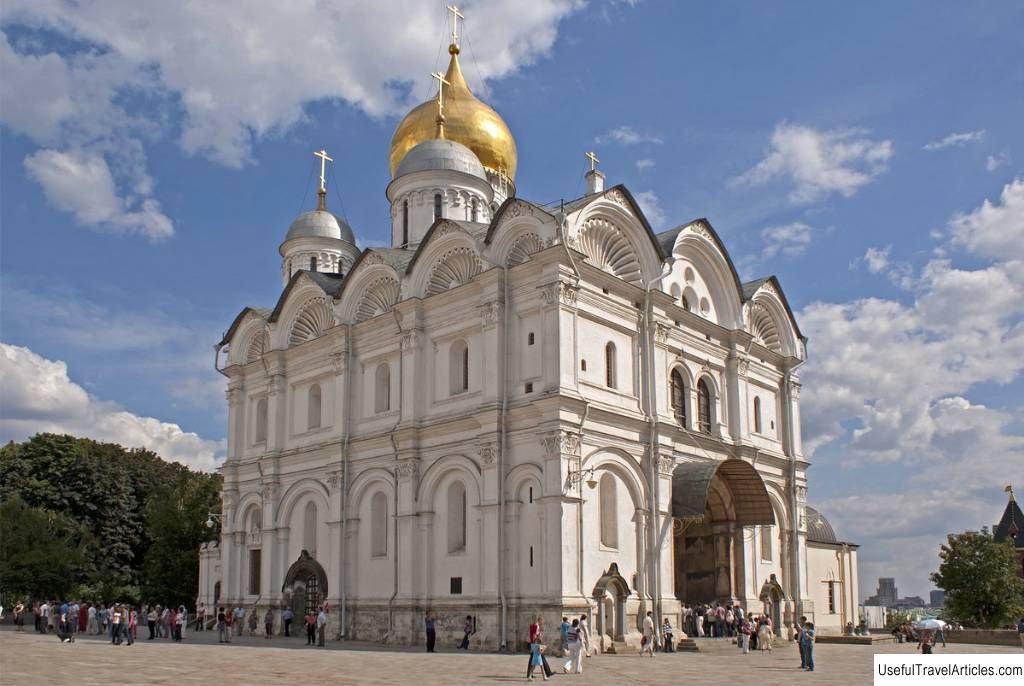
Archangel Cathedral of the Kremlin description and photos - Russia - Moscow: Moscow. Detailed information about the attraction. Description, photos and a map showing the nearest significant objects. Photo and descriptionArchangel Cathedral on the Kremlin Cathedral Square , like other local churches, is part of the State Historical and Cultural Museum-Reserve "Moscow Kremlin". It was built at the beginning of the 16th century in honor of the holy Archangel - the main archangel, the most revered not only in Orthodoxy, but also in other world religions. Archangel Michael was considered in Russia to be the heavenly patron of princes going on military exploits. The Grand Dukes came to the temple for a blessing, and after the wedding to the kingdom, another Russian emperor came to the Archangel Cathedral to bow to the graves of their ancestors. History of the construction of the templeThe first religious building in honor of the holy Archangel appeared in the center of old Moscow in the middle of the XIII century . The wooden church was erected by order of the brother of Alexander Nevsky, the Moscow prince Mikhail Khorobrit , who died soon in a battle with the Lithuanians. The church stood for almost a hundred years, until in 1333 a white-stone church was consecrated in its place. It was built by Ivan Kalita , Prince of Moscow and Grand Duke of Vladimir, who thus thanked the higher powers for ending the famine in Russia. The stone temple was small and single-domed, and members of the grand ducal family began to be buried within its walls. A few decades later, Theophanes the Greek , a famous icon painter and master of monumental fresco paintings, was invited to decorate the stone church. The Greek and his disciples also painted several icons for the church iconostasis, which was two-tiered and high. By the beginning of the 16th century, the church fell into disrepair due to frequent fires, and from time to time. A huge number of burials did not correspond to the capabilities of a small temple, and Ivan III Kalita , who then occupied the royal throne, ordered to dismantle the building. In 1505, the Italian architect Aleviz Novy was given the task to design and build a stone church in the best Russian traditions. Ivan III soon died and was buried in the unfinished cathedral, and the progress of construction work after his death was supervised by Vasily III . Aleviz Noviy managed to realize all the wishes of the customer. His own project was a traditional Russian Orthodox cross-domed church with five chapters and seven aisles. The cathedral was consecrated in honor of the Archangel Michael in 1508 . Cathedral chapels were built in honor of Andrew of Crete, John the Merciful, the First and Second Finding of the Head of the Prophet John the Baptist, Simeon the Stylite the Pilot, the Apostle Aquila and the Renewal of the Church of the Resurrection of Christ. Cathedral before and after the revolution Moscow fires have repeatedly caused damage to the temple. It suffered especially badly in 1547 when the fire severely damaged the wall paintings. The frescoes had to be restored, for which icon painters were invited from Novgorod and Pskov. The frescoes were restored a century later, when the Emperor Alexei Mikhailovich gave the order to bring down the old painting, after compiling a detailed description of it, and replacing it with new frescoes. Due to the wars with Poland and Sweden and the shortage of money in the treasury, the work dragged on for a long time and was completed only in 1666. An artel of masters who painted the Archangel Cathedral in the 17th century was headed by Simon Ushakov . By that time, the well-known Moscow icon painter was already the "honored" master of the Armory Order, and then - of the Armory Chamber. The school of icon painters Simon Ushakov enjoyed the special favor of Tsar Alexei Mikhailovich. Almost a hundred companions and disciples worked with Ushakov in the Archangel Cathedral of the Moscow Kremlin. Among them were Guriy Nikitin , the greatest master of frescoes and icon-painting of the second half of the 17th century, and Fyodor Zubov , the tsar's flag bearer and head of the favored icon painters of the Armory Chamber, who replaced Ushakov. Another fire that happened in 1737 and called Trinity , again brought destruction to the Archangel Cathedral. The temple had to be overhauled, and this happened already during the reign of Elizaveta Petrovna . As a result of the restoration at the Archangel Cathedral, the shape of the central chapter was changed, the southern wall was reinforced with vertical ribs of white stone, and the zakomars acquired a laconic and austere look. Inside, the reconstruction touched the icons, which were removed in silver frames, decorated with chasing and gilding. In 1742, Moscow Diocesan Administration was established and the Archangel Cathedral became the place where the pulpit was installed. The new status required a special luxury but also provided the temple with sufficient funding. The cathedral was constantly renovated and reconstructed. The fires were replaced by another trouble from Europe. The Napoleonic army, which occupied Moscow, outraged many Orthodox churches, and the Archangel Cathedral of the Kremlin was no exception. The priceless icons were damaged, the silver of their frames was melted into ingots, and a kitchen was placed in the altar, where they prepared food for Napoleon. The temple was re-consecrated in 1813 , and a few years later the central cathedral chapter was covered with gilding, and the corner domes were covered with tinplate plates. General cleaning was carried out in the cathedral in 1913 year : Russia was preparing to celebrate the 300th anniversary of the reign of the Romanov dynasty. Then the Royal Doors were restored and the iconostasis was washed, all church utensils were cleaned, and a canopy was built over the burial place of Tsar Mikhail Fedorovich, and lamps were lit. The revolution brought many changes and the Archangel Cathedral, like other Kremlin churches, was closed in 1918. Restoration work began almost immediately - repairs were required after shelling during the 1917 armed uprising. The staff of the created on the initiative of the academician and artist I. Grabar of the scientific restoration center, the icons were strengthened and covered with protective material, many images were restored, and later, the 17th century murals were opened. Since 1955, a museum has been opened in the Archangel Cathedral of the Moscow Kremlin. What to see in the Archangel Cathedral- The main portal is located in a recess of impressive width, in the form of a powerful arch with paintings on the ceiling. It is decorated with vegetal stone ornaments and crowned with carved acroteria - attachments on the top of the pediment. The interior of the Archangel Cathedral is able to impress any admirer of Old Russian painting: - On the pillars and the walls of the first tier are portraits of Russian princes . Among the sixty images, Ivan Kalita, Dmitry Donskoy, Vasily III are easily recognizable. - The ceiling of the dome and the walls of the central drum contain paintings on biblical themes , small domes - portraits of archangels, saints and scenes from the life of the Archangel Michael. - Icon painters placed the compositions of the Theotokos cycle above the altar. The Dormition of the Theotokos fresco looks especially majestic . - In the western part of the church, you can see a cycle of artistic murals on the theme of the Articles of Faith . - The oldest frescoes and wall paintings preserved in the Archangel Cathedral date back to the 17th century . The necropolis of the Archangel Cathedral includes 54 burials. The very first in the temple was buried Ivan Kalita, who laid it. Tsars Ivan the Terrible and Fyodor Ioannovich and the innocently murdered Tsarevich Ioann Ioannovich are buried in the chapel for the royal tomb, built in the 16th century. Iconostasis of the temple Iconostasis of the Arkhangelsk deserves special attention Cathedral of the Moscow Kremlin. The iconostasis is the altar partition, which runs between the northern and southern walls of the temple and usually consists of several rows of icons. The iconostasis separates the altar part of the church from the rest of the premises. In the Archangel Cathedral, it is a frame structure decorated with carved colored decor. The height of the iconostasis is 13 meters, and it was made in 1680 at the Amusement yard. The first iconostasis, installed in 1508 during the construction of the cathedral, died in a fire in 1547. The iconostasis of the Archangel Cathedral is divided by horizontal cornices into four tiers and consists of three vertical parts. The four tiers of the iconostasis are traditional: prophetic, deesis, festive and local rows. The bulk of the images for the iconostasis were painted by artists Fyodor Zubov, Dorofey Zolotarev and Mikhail Milyutin. This was in 1681. Among the icons there are also older ones dating from the XIV-XVI centuries. The center of the prophetic row is occupied by the image of the Mother of God on the throne , and on either side of it are images of Old Testament prophets with scrolls containing texts their predictions. In the Deesis row, it is worth paying attention to the central composition Savior in Strength . Other icons of this tier depict the Mother of God with the Archangel Michael and John the Baptist with the Archangel Gabriel. The festive rite tells about the church holidays mentioned in the New Testament. In the local tier, patronage saints are represented, who were venerated by the great dukes and sovereigns of Russia. The most ancient image of the local row is an icon painted at the end of the 14th century by order of the widow of Dmitry Donskoy and depicting the Archangel Michael with deeds.        We also recommend reading Landhaus description and photos - Austria: Klagenfurt Topic: Archangel Cathedral of the Kremlin description and photo - Russia - Moscow: Moscow. |
